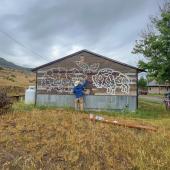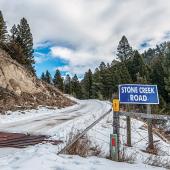Crooked Paths
In 1965, Secretary of Interior Stewart Udall directed a nationwide trails study, which produced a report called “Trails for America.” President Lyndon B. Johnson, who called for the study, said:
“We can and should have an abundance of trails for walking, cycling, and horseback riding... In the backcountry we need to copy the great Appalachian Trail in all parts of America, and to make full use of rights-of-way and other public paths.”
From the Proposed New Trail & Reconstruction table, 53 states and territories are listed. Montana had the second-highest miles proposed at 7,129 miles across all the public land agencies; 4,248 miles were pre-existing, simply needing reconstruction.
One of these “public paths,” which did not have a “perfected prescriptive easement” until a recent court case, is the Indian Creek Trail outside Ennis. Labeled Trail #328 on Forest Service maps, it passes through the Wonder Ranch and has had historic public access since at least 1888. No recreationist needed to ask for permission to hike into the national forest and onward to No Man Lake, for instance, or to Circle Mountain or the Sphinx. In 1940, the USFS included this trail in the Beaverhead National Forest map, publicizing it as part of the National Forest Trail System.
In 1968, the Wonder Ranch was sold to the Hudsons from Dallas, Texas. In the 1980s, the Forest Service placed signs along the route and constructed a major trailhead facility to serve the trail. In 1985, the Texas out-of-state landowners installed two wooden signs near the trail entry, reading, “Wonder Ranch – Private Property – Please stay on trail to Forest boundary – 1/4-mile.” In the early 1990s, the USFS posted a sign at the trailhead to define and defend our public access: This is Public Access across Private Land. Please, stay on the road or trail to the National Forest boundary. Recently, that access was challenged by the Wonder Ranch. Thankfully, the USFS secured our public prescriptive-easement rights before the United States District Court on October 24, 2016.
Now, that legal process to secure our public prescriptive easements is in jeopardy—not just on one trail, or in one forest, or even in Montana alone, but across all of our federally-managed public lands nationwide. Most recently, a Trojan Horse was rolled out of the Crazy Mountains—a self-serving political agenda targeting the easement process. Certain Crazy Mountain landowners, some of whom outfit and graze our public lands, are also ranking members of organizations such as the Montana Outfitters & Guides Association, Montana Farm Bureau Federation, and the Montana Stockgrowers Association. These landowners leveraged their positions, organized letters of complaint—including false allegations—against the local district ranger, who was protecting historic public access to trails and roads on Forest Service maps. One of the landowner’s demands: remove all roads and trails lacking formal easements from future maps. These special-interest letters were directed to the Custer-Gallatin National Forest Supervisor and Senator Steve Daines. Daines then forwarded these false allegations in an official capacity, without due diligence into the truth, to Forest Service Chief Thomas Tidwell, Region 1 Regional Forester Leanne Marten, and the newly sworn in Secretary of Agriculture, Sonny Perdue.
Perdue attended the Montana Ag Summit in May, where landowners brought up the Crazy Mountains situation. He and Secretary of Interior Ryan Zinke also received a letter from Texas Rep. Pete Sessions, suggesting legislation or agency directives against the historic prescriptive-easement process. Sessions claimed his interest was due to a Dallas constituent, the Wonder Ranch owner. But Sessions also has a major donor who owns land near the Crazies.
The result? The district ranger was reassigned. But that was simply a pretext, a Trojan Horse, to their real goal: the taking of our public lands, nationwide. By cutting off public access through our historic trails and roads, they essentially privatize the public lands and the wildlife we all own—lands that the federal government simply manages as our public trust.
We can’t ignore these Trojan Horse machinations; public land is too valuable. We can’t ignore the targeting of government employees, or who will defend our access? We need to dismantle the privatizing agenda, while defending the employees who preserve and manage public lands on our behalf—then both will be secured.
Kathryn QannaYahu is the founder of Enhancing Montana’s Wildlife & Habitat. Find out more about this and other public-access issues at emwh.org.












